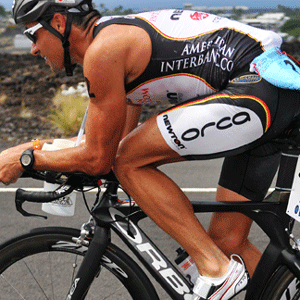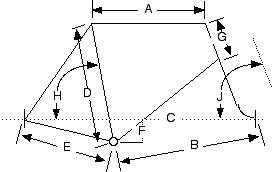Seat height
You'll want to follow the articles in succession, starting with Intro to the F.I.S.T. Method:
1. F.I.S.T. axioms
2. F.I.S.T. protocol
3. Measuring conventions
4. Seat height <– You are here
5. Cockpit length
6. Hip angle
7. Armrest drop
8. Tools of the trade
9. Your bike's "waistline"
10. Translating fit specs to bike specs
If you're following this series start to finish, you should've read our article on Measuring conventions prior to this. Our series begins here.
There are plenty of ways to measure seat height, but my preference is to measure it while you're on the bike and in the pedaling mode. In choosing this method of proper saddle height identification, this is now the easiest parameter to "eyeball," and the hardest to measure. It's easy to eyeball because most people can correctly determine a saddle height that's too high or low just by watching a subject pedal his bike.
But it's hard to attach precision and objectivity using this method without paying particular attention to the angle of one's ankle at bottom-dead-center (BDC). You must pay a lot of attention to how the subject pedals: the aspect of his shoe at the bottom of the pedal stroke, the angle of his ankle, and the angle of his knee. It is common, for example, for a rider to have finished dropping through with his heel before BDC, and for his ankle to have risen in elevation right at BDC. Whatever it is he's doing during his pedal stroke must be reproduced by you (if you're playing the "fitter"), when he's stopped for his "snapshot" at BDC. It is during this snapshot that you measure his knee angle.

BDC is not at the absolute bottom of the pedal stroke (with the crank arm at 6 o'clock). It's with the crank at 5:25, or 5:27 (let us say) as is the case in the illustration.
You can also see from the photo that "knee over pedal spindle (KOPS) can be thrown out the window for this application (tri bike fit) because Swedish pro triathlete Jonas Colting (pictured) is riding a very steep position (80 degrees or thereabouts), and his knee is going to be well in front of the pedal spindle.
Frequently you'll read that knees should be flexed about 30 degrees (and this number is repeated by others without any real thought process invested in this measure). This is 30 degrees from what? Going through where? Where is this line through which one starts, before one flexes one's knee 30 degrees? You just about never (do a Google search on this) get to see a photo or any very good description of the methodology used to find this 30 degrees angle of which so many write.
Better to use the actual angle created by your actual leg, no? This is the obtuse angle created by the knee joint, and it's simply 180 degrees minus that 30 degrees (yes, 150 degrees).

But there's more to the story. First, there's one good reason we can measure obtuse angles — because we have the tools to do so. For all our angles we'll use a specific goniometer (an angle finder with telescoping arms that allow us to measure angles made by long levers, like the goniometer shown in the photo adjacent).
In order to find the knee angle with precision, you've got to decide on precise points from which to measure. In my case, I've chosen the dead center of the knee, on the lateral side, as the apex of the angle.
The two arms of the angle pass through the greater trochanter and maleolus respectively. Each is a bony protrusion. The first is the outside of the hip, (but is not part of the hip joint proper; it is the bony head of the femur, and is just below the hip joint as you're standing up). The maleolus is the bony protrusion of the ankle, the "Kathy Bates" bone, if you saw the movie Misery.
I like 145 degrees of knee angle, but that's not the beginning and end of it. A proper range might be 140 to 150 degrees. Old time roadies-turned-triathletes tend toward the lower end of that range, that is, a slightly more flexed knee with a slightly lower seat height. Runners-turned-triathletes tend, in my experience, toward the higher end, on average.
I ride a very traditional road race seat angle, and a very steep, non-traditional tri bike angle. That might seem incongruous were not not for so many road racers now doing the same thing (CSC's stable of racers come to mind). I tend more toward the 143 degrees angle on my road bike, and more like 145 degrees on my tri bike. I don't know why, but I think this is typical. This somewhat accounts for my taller saddle height on my tri bike than on my road bike.
In actuality my saddle is 10mm or 12mm taller on my tri bike, more than is justified by a 2° knee angle variance. Most if this delta is accounted for by difference in where I sit on the saddle. On my road bike I'm rearward, on my tri bike I'm nearer the nose, and if you simply measure the difference from the nose to the bottom bracket versus a point near the rear of the saddle to the bottom bracket, you'll see an extra 7mm or 8mm of seat height difference, depending on the tilt of your saddle.
Most people are right around 150 degrees when on their tri bikes in the aero position, but I don't much care what seat height a subject chooses between that 8 degrees range starting at 145 degrees of knee angle. Whatever he likes is okay with me. If it's slightly below 145 degrees I'll not be much concerned, as long as he rides with a cadence that makes sense, say, almost always above 85rpm. I'm not crazy about overly low seat heights combined with low cadences, as this appears to me a potential for some patellar tendon issues.
I'm more wary of saddle heights that are on the tall side, and as the knee angle gets to 153 degrees and even creeps above that I get more and more nervous. One thing subjects must understand: muscles tighten as they fatigue. Try to touch your toes 70 miles into a hard, hot, 90-mile bike ride (you're lucky if you can touch your ankles). This established, imagine what your muscles are going through with a saddle height on the too-tall side. This is when riders are more likely, in my experience, to be at risk of some soft tissue damage. Best to listen to your legs' "voices" deep into a long bike session.






Start the discussion at forum.slowtwitch.com